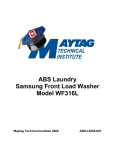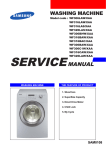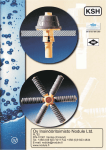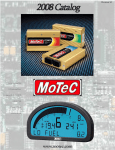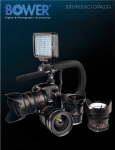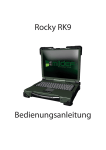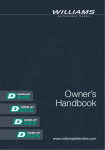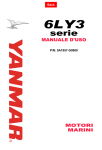Download Yanmar BY series Installation manual
Transcript
Electronic Control System Operation Manual for 6LY3 Series Engines ELECTRONIC CONTROL SYSTEM MANOPLYm01 Revision 3.0 Notice to Boat Manufacturer, Installer, and Consumer Throughout this manual, warnings are used to alert the installer/operator to special instructions concerning a particular service or operation that may be hazardous if performed incorrectly or carelessly. Observe these alerts carefully! These “safety alerts” alone cannot eliminate the hazards that they signal. Strict compliance to these special instructions when performing installation, operation, and maintenance plus “common sense” operation are the most effective accident prevention measures. Warning This device should not be used as a navigational aid to prevent collision, grounding, boat damage, or personal injury. When the boat is moving, water depth may change too quickly to allow time for you to react. Always operate the boat at very slow speeds if you suspect shallow water or submerged objects. RECREATIONAL CRAFT DIRECTIVE 94/25/EC This product has been designed to be compliant with the above Directive. Maximum performance, and compliance with the EMC Directive, can only be ensured by correct installation. It is strongly recommended that the installation conforms with the following standards: APPLICABLE STANDARDS a) ISO 8846 Small Craft-Electrical Devices Protection against ignition of surrounding flammable gases. b) ISO = International Standards Organization This device meets or exceeds the applicable ABYC, ISO, and USCG safe boating rules, regulations, standards, and guidelines. SAFE BOATING ON THE WEB U.S. Coast Guard www.uscg.mil U.S. Power Squadron www.usps.org NMEA 2000® is a registered trademark of the National Marine Electronics Association. Disassembly and repair of this electronic unit should only be performed by authorized service personnel. Any modification of the serial number or attempt to repair the original equipment or accessories by unauthorized individuals will void the warranty. Handling and/or opening this unit may result in exposure to lead, in the form of solder. The information contained in this manual is believed to be accurate at the time of going to print but no responsibility, direct or consequential, can be accepted for damage resulting from the use of this information. The manufacturers reserve the right to make changes, without notice, to any of its products. Contents System Overview.......................................................................................................................................... 4 Helm Components...................................................................................................................................................4 Start Up......................................................................................................................................................... 5 Redundant (Back Up) Throttle. ................................................................................................................... 5 Shift & Throttle Control Head Functions................................................................................................................8 Control Head Operation .........................................................................................................................................8 Operation...................................................................................................................................................... 9 Identification...........................................................................................................................................................9 Select/Change Station.............................................................................................................................................9 Indicator Dimming Feature.....................................................................................................................................9 Shift Disconnect (SD)...........................................................................................................................................10 Split Range Throttle (SRT)...................................................................................................................................10 Sync Operations....................................................................................................................................................11 Cruise Sync (CS) ...........................................................................................................................................11 Power Train Sync (PTS).................................................................................................................................11 System Alarms......................................................................................................................................................12 Optional Trolling Mode.........................................................................................................................................13 i5601E Digital Display Alarms/Diagnostic Code Screens ...................................................................................14 Engine Alarms.......................................................................................................................................................15 Engine Diagnostic Codes......................................................................................................................................15 Maintenance Warning............................................................................................................................................15 Diagnostics............................................................................................................................................................16 Power Reduction Mode.........................................................................................................................................16 Appendix A: i5601E Digital Display Setup.............................................................................................. 17 Display Settings..................................................................................................................................... 18 Menus..................................................................................................................................................... 18 User Settings and Factory Settings........................................................................................................................19 “Unlocking” the Hot Keys....................................................................................................................................19 Quad Screen Parameters........................................................................................................................................20 Appendix B: i5601E Menu Navigation ................................................................................................... 21 Appendix C: Default Settings .................................................................................................................. 22 Appendix D: Fuses..................................................................................................................................... 23 Appendix E: Trouble Codes...................................................................................................................... 24 Appendix F: Network Status.................................................................................................................... 25 Appendix G: Station Select Protection.................................................................................................... 26 Electronic Control System: Operation Manual for 6LY3 Series Engines Page System Overview Although the scope of this document relates to both single and dual engines, the instructions within depict the more widely used dual engine configuration. Helm Components This dual engine electronic control system consists of the following helm equipment: • Two Yanmar i5601E Digital Displays (one, if single engine) • Dual Shift & Throttle Control Head (single shift & throttle control head, if single engine) Yanmar i5601E Digital Display Note: Displays “Single” if single engine configuration. The i5601E displays real-time data as well as warnings or alarms for any engine abnormality. Diagnostic codes will be stored for future reference by a Yanmar technician. Shift & Throttle Control Head CH67601: Trolling Switch (optional) The Shift & Throttle Control Head selects the gear positions and the throttle settings. The Control Head has several lights that confirm modes of operation and display warnings, if present. Buttons enable engine RPM synchronization and shift disconnect as well as setting the brightness of the lights. Other control configurations with similar functions may be used. Page Electronic Control System: Operation Manual for 6LY3 Series Engines Start Up Your electronic engine control system was configured at the factory with the default settings needed to initially start the system. See Appendix C. 1. Connect the battery terminals and turn the master battery switches to the “ON” position. Turn the engine control breaker switches on at the main breaker panel. Before starting the engines for the first time, take a moment to familiarize yourself with the shift and throttle controls and ignition switch. With the engines not running, move the control levers over the full range until you are familiar with the feel. Note that the detent pressure and drag can be adjusted using the adjusting screw on the front surface of the control head. The top screw sets the detent pressure; the lower screw sets the drag. Next, look at the ignition switch panels. The ignition switch may be a “rocker” type or conventional key type switch. On either type there are three positions: OFF – ON – START. Normal engine shut down is achieved by moving this switch to the OFF position. Next to the ignition switch is an EMERGENCY STOP switch. Moving the rocker switch to the off position (or turning the key to off) WILL result in the engine shutting down. WARNING In normal operating mode, the engine is started and stopped with either the key switch, or the off-onstart rocker switch. When you switch to the OFF position, the engine can take up to about 5 seconds to stop running, allowing the engine to store certain information and make adjustments for easier restart. In an emergency situation, you can use the Emergency Stop switch to kill all power to the engine. This will allow you to stop at once, but will not store data and make adjustments for an easy restart. A DTC (Diagnostic Trouble Code) will be generated and stored in the system indicating that the Emergency Stop was activated. You will notice the next time you start, that the engine will crank over for an unusually long time. This is normal for the engine to regain its memory and functions. The Emergency Stop should only be used in an emergency. 2. Place the control levers in neutral and turn the PORT ignition switch to the On position -- but do not start the engine. The green control head light will illuminate. a. Check to see if the green light on the control head is solid or flashing. If solid, proceed to the next step. If flashing, push the Select button to select the head. Position the control lever to neutral and the yellow light will now come on. b. Start the port engine. c. Turn on the starboard ignition systems. d. After a two-second wait, start the starboard engine. Redundant (Back-up) Throttle In the unlikely event that the throttle signal is lost between the helm mounted shift/throttle control head and the engine, the system is designed to revert to the redundant or back-up throttle. First, the engine would reduce rpms to idle speed, the digital display would show “Throttle Error,” and a small red indicator light would flash at the key panel (or switch panel). Near the red light is a small potentiometer (looks like a volume control knob). Turn the knob all the way to counter-clockwise in order to take control of the throttle. Then turn the knob SLOWLY clockwise - the light will glow solid. You will have control of the throttle, however, you will NOT have shift control. At this point you must shut the engine off and restart, to return throttle control back to the shift/throttle control head. See transmission instructions for manual shifting. Electronic Control System: Operation Manual for 6LY3 Series Engines Page Start Up When powered-up, the i5601E Digital Displays will initially display an introductory screen showing the software revision level. They will then display one of the following four screens: These screens show all of the key engine data and can be accessed by pushing a single button. The right-most button allows the contrast and brightness to be set. Page Electronic Control System: Operation Manual for 6LY3 Series Engines Start Up In the unlikely event that an engine fault occurs, a warning box appears in the display showing the cause of the fault, and the action to take, "Press Any Key To Continue." Pressing any key acknowledges the alarm and immediately switches the display to the Alarms screen. The i5601E continues to beep until all alarm conditions (engine faults) have cleared. Unacknowledged alarms are shown as flashing boxes. Press any key to acknowledge alarm boxes that may still be flashing, and they will then change to a steady highlighted state. Alarm blocks remain highlighted as long as the alarm condition (engine fault) remains and will automatically reset to an un-highlighted state after the alarm condition has passed. Engine Diagnostic Code Summary Screen Note: The i5601E is an extremely versitle display. The four-left keys can be reconfigured to allow the user to display whatever screens he or she desires. For additional operational details, refer to Appenbdix A and the technical manual. Electronic Control System: Operation Manual for 6LY3 Series Engines Page Start Up Shift & Throttle Control Head Functions The Shift and Throttle Control Head comes with a dual function, single lever control. A single lever control initiates both shifting and throttle for a single engine. Control Head Operation WARNING The boat will start to move during the next steps. Be very cautious when first engaging the gears to establish that forward is truly forward and reverse is truly reverse. A quick in-and-out of gear test is recommended. Ensure that the boat is clear of all obstacles forward and aft before conducting this test. 1. With the engine running and the control head(s) in neutral, the green and yellow control head lights should be illuminated. 2. Press the Neutral button(s) on the control head. The Neutral control head light(s) should flash. 3. Advancing the control lever(s) to the forward detent (that is, the position identified by a “click” feel) puts the boat in forward idle. Pushing the lever further forward increases the throttle setting. The same is true in the reverse direction. Note that the detent pressure and drag can be adjusted using the adjusting screw on the front surface of the control head. 4. Return the control handle(s) to the neutral position. 5. Press the Neutral control head button(s). The neutral light(s) will stop flashing and remain continuously lit. Page Electronic Control System: Operation Manual for 6LY3 Series Engines Operations Control Head Operation The boat will start to move during the next steps. Be very cautious when first engaging the gears to establish that forward is truly forward and reverse is truly reverse. A quick in-and-out of gear test is recommended. Ensure that the boat is clear of all obstacles forward and aft before conducting this test. Warning Identification Engine Trim Control: in the handle (optional) Lever Position Indicators: Adjustable Lever Feel Starboard Port Shift Detent Throttle Friction Select/change Station: NOTE: Station Protection may be turned on, see Appendix G. A lit green SELECT lamp indicates a station is active. • On single station boats, station selection is automatic. • For mutli-station boats, choose a station and then press SELECT button with levers in neutral. to Change Stations: • Move to new station and press select button. (Green lamp flashes.) • Match control handle positions with those of active station. (Green lamp goes steady when levers match and this station is now in control.) Indicator Dimming Feature: Push select button and the lamps will dim. There are four degrees of brightness from which to choose. NOTe: Indicator Dimming is only accessible from the active control station. (Green lamp on steady.) Electronic Control System: Operation Manual for 6LY3 Series Engines Page Operations NOTE: The flashing yellow N (Neutral) lamp can indicate status of either Shift Disconnect (SD) or Split Range Throttle (SRT). Please exercise caution when engaging/disengaging either of these modes! A steadyon Neutral lamp ALWAYS indicates engine is in NEUTRAL. Shift Disconnect (SD): Flashing yellow N (Neutral) lamp indicates SD engaged for this engine. Allows throttle control without gear engagement. TO ENGAGE Shift Disconnect: • Move engine’s lever to the “Neutral” position. • Press the N (Neutral) button next to this lever. (Yellow lamp flashes.) To Disengage Shift Disconnect: • Return engine’s lever to the “Neutral” position. • Press N (Neutral) button next to this lever. The yellow N (Neutral) lamp will go out - SD is disengaged and the engine and transmission will now respond to lever commands. Split Range Throttle (SRT): Flashing yellow N (Neutral) lamp - SRT engaged for this engine. Provides greater throttle sensitivity: moving an engine’s control lever to “Full Forward” will only produce the maximum percentage of WOT (Wide Open Throttle selected at set-up - default Throttle Limit is 25%) TO ENGAGE Split Range Throttle: • Move engine’s lever to Forward Idle position. • Press N (Neutral) button next to this lever. (Yellow lamp flashes.) TO DISENGAGE Split Range Throttle: • Move engine’s lever to Forward Idle or Reverse Idle • Press N (Neutral) button next to engine lever. The yellow N (Neutral) lamp will go steady - SRT is disengaged. Page 10 Electronic Control System: Operation Manual for 6LY3 Series Engines Operations Sync Operations: note: Your system ships with Cruise Sync set as the default. Power Train Sync may be selected using the i5601E display. Cruise Sync (CS): Default Automatically synchronizes engine RPMs when levers are close together and above 20% forward throttle. A lit red SYNC lamp indicates sync is enabled. To Enable CS: • Press SYNC button. (Red lamp flashes.) • Match control handle positions within 10% of each other. (Red lamp goes steady when levers match — CS is now enabled.) CS Automatic Engagement: • When levers are moved within 10% of each other and over 20% forward throttle. CS Automatic Disengagement: • When levers are moved more than 10% apart or under 20% forward throttle. To Disable CS: • Press SYNC button. (Red lamp flashes.) • Match control handle positions within 10% of each other. (Red lamp goes off when levers match — cruise sync is now off.) Power Train Sync (PTS): Automatically synchronizes engines and transmissions; the port lever controls throttle and shift of both engines across the entire control range. A lit red SYNC lamp indicates sync is engaged. To Engage PTS: Note: Starboard lever may be chosen as master control using the i5601E • Press SYNC button. (Red lamp flashes.) • Match control handle positions within 10% of each other. (Red lamp goes steady when levers match — power trains are now in sync.) To Disengage PTS: • Press SYNC button. (Red lamp flashes.) • Match control handle positions within 10% of each other. (Red lamp goes off when levers match — power train sync is now disengaged.) Electronic Control System: Operation Manual for 6LY3 Series Engines Page 11 Operations System Alarms Critical Alarms Continuous flashing both lights on either side of the control indicates a Critical Alarm. System will do a “Safe Shut Down,” and must be serviced before further use. When a critical alarm occurs, the system will automatically go to the selected “Fail Safe Response” mode. The system MUST be shut down and restarted for most critical alarms. Some functions may operate for a time after restart. See display on Control Unit to determine cause of alarm. If the alarm is caused by the Throttle Actuator hitting “Stop” - Wide Open Throttle (WOT) - the alarm will go away when the throttle is pulled back. However, as with ALL Critical Alarms, the system must be serviced before further use. Non-Critical Alarms Intermittent flashing of both lights on either side the control (five seconds flash, normal for fifteen seconds, then repeating), indicates a Non-Critical Alarm. Acknowledge by a power up cycle or pressing the ENTER button on the Control Unit. Continue to operate and have the system checked as soon as possible. Page 12 Electronic Control System: Operation Manual for 6LY3 Series Engines Operations Optional Trolling Mode Note: The Trolling Mode must be calibrated before trolling will operate properly. See Installation Manual. The Trolling mode option allows the boat operator to slow the forward and aft speed of the boat for fishing. Trolling mode is achieved by the ECU electronically adjusting pressure bypass valves in the gearbox, allowing the clutches to slip. When trolling is selected on the Control Head or by pressing the separate trolling switch and the control lever(s) is moved forward, the boat will start to move at the slowest speed. As the lever approaches 60% throttle, the boat will be close to its non-trolling idle speed. Moving the lever(s) further forward will cause the transmission to lock out trolling and advance the throttle. The factory set defaults will limit throttle to 40%. The trolling defaults -- as shown in Appendix C -- can be set to a variety of operating modes. Contact your dealer for details, or see technical manual. How to Enter Trolling Mode: 1. Move the Control Head lever(s) to the “Neutral” position. 2. Start the engine(s) if necessary. The system must see RPM in order to permit trolling mode to be entered. 3. Press the separate trolling switch. This places the system in trolling mode. 4. When you move the Control Head lever(s) in either the forward or reverse direction, the engine RPM will remain steady, but the boat should move in the selected direction. 5. To take the boat out of the trolling mode, return the Control Head lever(s) to the “Neutral” position and press the Trolling switch. CH67601 Trolling Switch (optional) Control Lever Range of Operation Tro llin g 60% ... .... .. ... . .... .... .... . . . .. ... .... . . . ... .... .... . .... Th ro ttl e 40% 40% Throttle Full Lock-up Note: While engaged in Trolling mode, Split Range Throttle (SRT) is not operational. Electronic Control System: Operation Manual for 6LY3 Series Engines Page 13 Operations i5601E Digital Display Alarms/Engine Diagnostic Codes Performs the function indicated by a pop-up menu, if present. With no pop-up menu showing, briefly press to display the Lighting & Contrast menu. With no pop-up menu showing, press and HOLD to display the MAIN MENU. Buttons Down Arrow moves menu selection down Up Arrow moves menu selection up Right Arrow acts on current menu item Back Moves back to previous menu Engine Alarms/Diagnostic Codes The ALARMs / DIAGs Screen Menu allows user to go to the Alarm or Diag Code Screen. This is very useful in the HOT KEY Mode, as a dedicated hot key is not required to view these screens. User can hold Right most key down go into the menu mode and then via this menu access the desired screen. Page 14 Electronic Control System: Operation Manual for 6LY3 Series Engines Operations Engine Alarms The Alarm Screen will display the status of 20 defined alarms. A flashing black background indicates unacknowledged alarm; a solid black background indicates an acknowledged still in alarm state status. Engine Diagnostic Codes This screen displays the diagnostic code information. The title bar indicates the number of diagnostic items. Maintenance Warning Based on startup issues, the maintenance timer will activate between 50 and 60 hours of operation. A maintenance warning will be displayed on the digital display screen. To acknowledge this warning, press and hold the #5 (right most) button on the i5601E digital display for a few seconds until the main menu is displayed. Use the down arrow button to move the cursor to “Calibration.” Press the right arrow button, then go to “User Setting” menu. The arrow should be at the “Reset Maint. Time” selection. Press the right arrow key to reset. The warning will go away. After an additional 250 hours of operation the maintenance warning will be displayed again, and every 250 hours thereafter. This a reminder that periodic maintenance must be performed at these intervals. Electronic Control System: Operation Manual for 6LY3 Series Engines Page 15 Operations Diagnostics The digital display indicates if certain malfunctions occur. The system also stores certain DTC (Diagnostic Trouble Codes) for reference. These codes will help you or a technician to determine which subsystem has malfunctioned. Display and record all Trouble Codes so you can relay them to the technician. A listing of possible Diagnostic Trouble Codes are in Appendix E. There are also diagnostic lights built into the Electronic Control System to assist in troubleshooting. The shift/ throttle control head will flash to indicate improper operation (see the section on the control head function). There is an i8320 or i8325 electronic control module (ECU mounted in the engine room). On the ECU module are three LED indicator lights which normally flash to acknowledge proper operation. When the ignition switch is “ON” and/or the engine is running, the three small LED indicators will flash at various rates to indicate engine communication, ecu status, and nmea communication. THE NMEA communication is the data stream to the digital display, shift/throttle control head, and other modules. If any of the three LEDs fail to flash while the key is in the “ON” position (engine does not have to be running), there is a communication problem. For safety reasons, it is best to perform this test while the key is “ON” but the engine is not running. The LED not flashing will indicate the part of the system malfunctioning, and diagnosis should proceed in that subsystem. Power Reduction Mode An automatic protection mode called Power Reduction is included in the electronic control system to help protect the engine from major failure. The Power Reduction mode will be activated if: A.The coolant temperature reaches or exceeds 110° C (230° F). B.The boost pressure reaches or exceeds 250 kPa (36 psi). C.An Engine speed sensors error occurs. D.The Rack Position sensor is out of range. E.The fuel injection timer shows an abnormal value. F. A Throttle Position error occurs. When the Power Reduction mode is active, the engine speed is limited to 1,800 rpm or less for items A through E. Item F (Throttle Position error) will result in rpm returning to idle speed. [See “Redundant (Back-up) Throttle” description on page 5]. If the condition falls back below the threshold or the fault no longer exists, normal power will resume after engine shut-down and re-start. On multi-engine boats the following actions occur on Power Reduction. Condition Sync OFF Engine with Power Reduction Either Action Engines operate independently Sync ON Master Slave slowly matches master Sync ON Slave Master normal, slave slows Page 16 Electronic Control System: Operation Manual for 6LY3 Series Engines Appendix A i5601E Digital Display Setup The i5601E was set up at the factory with the keys assigned and locked as shown on page 6 of this manual. This mode is the default mode and allows start up and operation of the engine. It serves many applications quite well. The i5601E Digital Display unit has many additional features and capabilities. This section of the book shows the use of some of these features. Changing the basic set up is typically accomplished in one of two ways. 1. Go to the systems menu and alter basic selections 2. Enable the right arrow key on the basic screens to allow changing of the data shown in the default displays. To enter the Main Menu press and hold key 5 until the menu appears. To move around the menus use the softkeys at the bottom of the screen. The function of a particular softkey changes from screen to screen to whatever is most appropriate for the given screen. Keys 1 2 34 5 NOTE: Any changes to the setup menus may require reconfiguring the i5601E HOT KEY SETUP. Electronic Control System: Operation Manual for 6LY3 Series Engines Page 17 Appendix A Display Settings The Monitor Settings Menu allows setting of parameters that are specific to the display unit. Some settings such as Language and Lighting will be communicated to the other displays. Display Description MENU HOT KEYS LOCK UNITS LANGUAGE TACH RNG 0-5000 SPEED DEPTH OFFSET DEFAULT MONITOR BEEPER ON ABOUT Function Controls the actions of the keys Sets a variety of units to suit the operator Sets the language the unit will display Sets the tach range Allows adjustments to speed readings if available Allows adjustments to depth readings if available Returns the unit to the default settings Turns the key beeper on and off Supplies information about the display Menus This menu controls the key functions. There are three choices. 1. When the Pop-Up Menus feature is selected (drawing at right), the unit functions like a typical computer. A key push brings up a menu and you then use the keys to make a series of selections. This is the mode that allows new screen set ups to be selected and any screen to be accessed. 2. The Hot Key Locked selection allows keys 1, 2, 3, and 4 to be assigned as favorite screens. Pushing the key immediately brings up the selected screen. This mode will not display the right arrow over key 5. Thus the screens are locked when this is selected. This is the factory default setting. 3. The Hot Key selection allows keys 1, 2, 3, and 4 to be assigned as favorite screens. Pushing the key immediately brings up the selected screen. This mode will display the right arrow above key 5. That arrow allows the user to select various data inputs in the various sections of the screen. Page 18 Electronic Control System: Operation Manual for 6LY3 Series Engines Appendix A User Settings and Factory Settings • The user setting allows for reset of the maintenance timer. • The factory settings require a password to change. “Unlocking” the Hot Keys This is a popular way to expand the use of the i5601E. The default hot keys will remain active but you can select other data parameters in the various display areas. A right arrow becomes visible over key 5. Pushing that key then allows for selection of a number of data types in the various boxes. To unlock the hot keys and allow for additional data selections go to the Main menu as described on pages 17 and 18. Then select HOT KEYS. Exit the menu back to the normal operating screens. You will see a right hand arrow above key 5 when any key is pressed. The Right Arrow button allows the choice of an individual gauge. The choices available are shown on page 20. The choices are presented in alphabetical order. Example using a quad screen: 1 2 3 4 Hot Keys 5 1 2 3 4 5 Block Keys Each button cycles the related block through the list on the next page. Note: Data in NMEA 2000® format may be added to the CANBus system from a compatible device which feeds the optional parameters listed above. The i5601E display has the capability of displaying additional Electronic Control System: Operation Manual for 6LY3 Series Engines Page 19 Appendix A Quad Screen Parameters These data choices can be placed in any box of a quad screen or in the two small boxes of an engine data screen: The screen headings that are included in a standard (default) set-up are noted in bold. Screen Heading Battery Bearing COG Coolant Depth Fuel Rate Fuel Tank 1 Fuel Tank 2 Fuel Tank 3 Fuel Tank 4 Gear Heading Hours Load Network Oil Pressure Oil Temperature RPM Rudder Sea Temp SOG Speed (SOW) Tab Port Tab Stbd Trim Port Trim Stbd Throttle Torque Turbo Waste Water WP Dist XTE graph XTE value Page 20 Function Battery Voltage Bearing to Waypoint Course Over Ground Engine Coolant Temperature Depth of the water Fuel level if single engine Fuel level in Tank 1 Fuel level in Tank 2 Fuel level in Tank 3 Fuel level in Tank 4 Indicates the selected gear Current vessel heading Actual Engine Hours Percent load on engine Network voltage Engine Oil Pressure Engine Oil Temperature Engine Revolutions Per Minute Rudder Angle Sea Water Temperature Speed Over Ground Speed through the water Position of the Port Trim Tab Position of the Starboard Trim Tab Port Engine Trim Starboard Engine Trim The percent of throttle currently selected The percent torque the engine is developing The amount of turbo boost pressure The amount of waste in the holding tank The amount of water in the water tank The distance to the selected waypoint The cross track error from a best source The cross track error from a best source Typical Data Source Engine GPS GPS Engine Sonar Sender Sender Sender Sender Sender Engine Compass Engine Engine Engine Engine Engine Engine Sender Sender GPS Sender Sender Sender Sender Sender Engine Engine Engine Sender Sender GPS GPS GPS Electronic Control System: Operation Manual for 6LY3 Series Engines Appendix B i5601E Menu Navigation Performs the function indicated by a pop-up menu, if present. With no pop-up menu showing, briefly press to display the Lighting & Contrast menu. With no pop-up menu showing, press and HOLD to display the MAIN MENU. ALARMs / DIAGs MAIN MENU Diag Codes Alarms ALARMs / DIAGs Network Status MONITOR SETTINGS CALIBRATION Network Nodes MONITOR SETTINGS FACTORY SETTINGS HOT KEYS LOCK Units Menu Password Protected Language Menu USER SETTINGS Tach Range 0-3000 Reset Maint. Time SPEED Docking Mode Depth Offset Default Monitor Fwd Throt Curv 1 Beeper ON Rev Throt Curv 1 About Split Range Prog Shift Delay Station Protect CALIBRATION 0.0 N USER SETTINGS TROLLING TROLLING Troll Mode FACTORY SETTINGS Eng Display: PORT SPLIT Lever 40 % Max Throttle 50 % VALVE CAL Set Idle rpm Sync: Pwr Train Lead Eng: T Engage Dly Port 0.0 Setup TROLL Valve Fixed Shift Dly: Buttons SETUP TROLL VALVE RPM ENGAGE Trans Type 450 ZF 0.0 SYSTEM SELECT “Down” Arrow moves menu selection down “Up” Arrow moves menu selection up “Right” Arrow acts on current menu item “Back” Moves back to previous menu Electronic Control System: Operation Manual for 6LY3 Series Engines Page 21 Appendix C Default Settings For single engine configuration, the engine interface part number is i8320 (no trolling) or i8325 (with trolling). The settings are the same as the dual engine configuration below. Without Trolling Engine Interface part number i8320P i8320S Idle RPM700700 Sync Cruise Cruise Lead Engine Port Port Split Range Throttle 25% 25% Forward Throttle Curve F5 F5 Reverse Throttle Curve R1 R1 Programmable Shift Delay7.27.2 Fixed Shift Delay 0.2 0.2 Station Select Protection Off Off With Trolling Engine Interface part number i8325P i8325S Idle RPM700700 Sync Cruise Cruise Lead Engine Port Port* Troll Trans Type ZF ZF Troll Engage RPM 850850 Split Range Throttle 25% 25% Forward Throttle Curve F5 F5 Reverse Throttle Curve R1 R1 Programmable Shift Delay7.27.2 Fixed Shift Delay 0.2 0.2 Station Select Protection Off Off Troll Mode** Split Split Troll Lever Travel 60% 60% Maximum Throttle in Troll Mode 40%40% Troll Throttle Engage Delay 0.2 0.2 Note: A system reset may be needed for some changes to take effect. *Only shows when Sync is set to Power Train **Troll Mode functions are not displayed until Troll Mode is selected. Page 22 Electronic Control System: Operation Manual for 6LY3 Series Engines Appendix D Fuses There is a fuse on the back of both the lower station and upper Station Ignition Switch Panels. It is a 5 amp fuse, designation AGC SA. Electronic Control System: Operation Manual for 6LY3 Series Engines Page 23 Appendix E Diagnostic Trouble Code Descriptions NOTE: On the digital display the DTC “Y” code will be shown along with additional information for that code. This information will further define the fault. Please make note of all the information details with the Y code before notifying your Yanmar service technician. DTC “Y” CODE System Description Y0010 Camshaft Position Sensor Y0011 Engine Overspeed Y0012 Crankshaft Position Sensor Y0014 Coolant Temperature Sensor Y0015 Intake Air Temperature Sensor Y0016 Turbo Boost Pressure Y0018 Oil Pressure Sensor Y0019 Oil Temperature Sensor Y0020 Fuel Temperature Sensor Y0025 Throttle Position Sensor Y0033 System Voltage Y0048 Communication Link Y0059 Redundant Throttle Y0070-Y0073 Rack Position Control Y0074 Injection Timing Control Y0088 Control Module Error Y0098 Voltage Supply Y0099 ECU Temperature Page 24 Electronic Control System: Operation Manual for 6LY3 Series Engines Appendix F Network Status The i5601E has several screens to help technicians diagnose errors on the NMEA 2000® Data Bus. See i5601E Operation on page 17 and Menu Navigation on page 21 to locate this screen. Network Status Display Accesses the Network Status Display Screen. The purpose of the display is to show details of the Network and allow determination of Network Problems. (The values are constantly monitored and do not rely on the screen being displayed.) Bus Load: Peak Load: Frames/Sec: Total Frames: Error Frames/Sec: Errors Total: Bus Off Bus Voltage: Current bus load over 1 sec Peak Load since last Reset Current frames transferred over 1 sec Total number of frames received since last Reset Error frames over 1 sec Total Number of errors received since last Reset If YES, indicates unit is not Transmitting on Bus Measured Value of Bus Supply Buttons: “Reset” – Resets the various parameters that have accumulated values “Back” – Moves back to previous menu Network Nodes Display The Network Units Display shows Yanmar and Teleflex units that have claimed an address on the bus. From the information in the claimed message name (Device Class, Function, and Instance Fields) the type of Model number of the unit will be determined. (The specific model may not be indicated, but it will give a general model of the type of the unit.) i.e. i813x. The information displayed consists of: • Node Address • Manufacturer’s Code - (All mfg’s codes will be shown, but only Yanmar and Teleflex units will show the mfg’s name) • Manufacturers Model Info - On some units the ending letter signifies the following: P - Port S - Starboard C - Center Engine Buttons: “Down” Arrow – Scrolls screen down. “Up” Arrow – Selects Node Detail Screen “Back” – Moves back to previous menu Electronic Control System: Operation Manual for 6LY3 Series Engines Page 25 Appendix G Station Select Protection Station Select Protection prevents accidental switching between control stations on multi-stationed boats. If turned on, a change of control stations requires that control head buttons be pressed in a specific sequence SELECT, SELECT, NEUTRAL, SELECT to change stations. The menu options are: • Station Select Protection Off (N) (Default Setting). • Station Select Protection On (Y). NOTE: If the status of Station Protection is in question, it may be checked through the i5601E Digital Display. Sequence: “Main Menu - Calibration,” “Calibration,” “User Settings.” “Station Protect” is the last option under “User Settings.” OR try to set the second station - if Station Protection is on (Y) Station Select will not engage. Operation To change stations this is the button sequence: • Go to the station you wish to make active. • Press the Select button. • Press the Select button again. • Press the Neutral or ‘N’ button. • Press the Select button. • The station will go active (green light on solid) if the handles are matched with the originally active station. • If the green light flashes , match the handles with the originally active station and the green light will go solid. WARNING Until the green light is on solid, the original active station retains control of the boat. Page 26 Electronic Control System: Operation Manual for 6LY3 Series Engines Yanmar Marine International B.V. P.O. Box 30112, 1303AC Almere, The Netherlands Brugplein 11, 1332 BS Almere-De Vaart, The Netherlands Phone: +31 36-5493200 Fax: +31 36-5493209 Yanmar Co., Ltd Head Office 1-32, Chayamachi, Kita-Ku, Osaka 530-8311, Japan Yanmar Marine USA Corporation 101 International Parkway, Adairsville, GA 30103, USA Phone: +1 770-877-9894 Fax: +1 770-877-7565 Yanmar Asia (Singapore) Corporation Pte Ltd. 4 Tuas Lane. Singapore 638613 Phone: +65 6861-3855 Fax: +65 6862-5195 Dealer Network: www.yanmarmarine.com




























